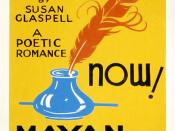Feminism
The theme of a story is expressed in many different ways. Things such as the title, characters, plot, and setting are all means in which a theme can be developed. In Susan Glaspell's "A Jury of Her Peers," she examines the theme of feminism by her use of the title, the characters and the plot.
First, Glaspell uses the title to let the reader know that ultimately Minnie Wright's fate will be decided by a "jury of her peers." Minnie's "peers" consist of two women, Mrs. Hale and Mrs. Peters, who can relate to and sympathize with Minnie's daily life. These two women will not only discover the evidence against her, but also judge the evidence. This is ironic, because during the early twentieth century women were not permitted to serve on a jury. In fact, women had very few rights in society during that time.
In keeping with that way of thinking, the men in the story believe the two women cannot be of any help. This is evident when the county attorney asks, "Would the women know a clue if they did come upon it?" (Glaspell 193). Yet, in this case, only women who "all go through the same things" can discover and understand the truth (Glaspell 200).
The use of names and the separation between men and women add to the theme of the story. The name Minnie Wright in itself is an example of the insignificant role women played in society in the early twentieth century. "The name 'Wright' plays off the social stereotype of women seeking 'Mr. Right,' while Minnie's name has double significance, 'Minnie' being 'mini' or 'minimized,' which is descriptive of her relationship with John and in general of women's relationship with men" (Bourne). Early in the story, when...


